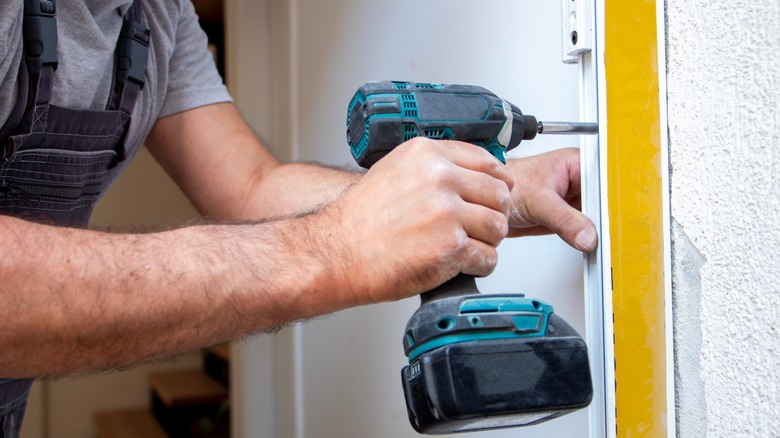The Time Joanna Gaines Traded Basic Interior Doors For Something More Unique
We may receive a commission on purchases made from links.
Interior doors often don't bring much to a space beyond their intended functional purpose. Simple designs in white or another neutral color are the safe bet — you know that, regardless of how your style changes, your doors will blend right in and not clash with any of the other accents you choose. While this is still a common approach, designers like Joanna Gaines are beginning to see interior doors as both a functional piece and an opportunity for expression. Trends are starting to skew away from stark minimalism and builder-grade accents and towards more maximalist spaces that have personality, and Gaines' creative door swap on Season 3, Episode 1 of "Fixer Upper" is a perfect example of how to turn an often-forgotten element into the star of the show.
Rather than opting for plain doors, Gaines installed two reclaimed pieces she purchased secondhand. "My favorite part of this space are the antique pantry doors I found while antique shopping," she shared on the Magnolia Blog. "When I found them, I knew they'd be perfect for this space, and had them installed to add an extra layer of history and dimension to this home." You should never underestimate the power of adding antiques to a room, as even a switch as simple as a pantry door can make a major impact on the feel of a space. Thankfully, this is an incredibly easy DIY to accomplish in your own home. With some dedicated shopping and a few basic tools, you can pull it off in just a few hours.
How to find the perfect antique door
If you want to do this project, the first step (and the one that will likely take the most time) is shopping. Finding an antique door that is in good condition, will match your intended design style, is within your price range, and will fit into your existing door frame can take some effort. Back in the day, door sizes weren't quite as standardized as they are now, so it may be a struggle to find something that's the perfect fit off the bat. If you do, great! This will make the installation process much simpler. If not, however, you might have to source a door that's slightly larger and cut it to size, consider alternative mounting methods, or talk with your contractor to slightly modify your plans if you're doing a major renovation or a new build.
As for sourcing, you have plenty of different options. The reclaimed wood design trend has been popular for a while now, so it's not uncommon to find people selling old doors and other building materials through Facebook Marketplace, eBay, and Craigslist. Depending on where you're located, you also might have access to a nearby salvage store or Habitat for Humanity ReStore that specifically focuses on selling materials for repurposing or construction. Finally, there's the approach Gaines chose. Antique stores are everywhere, so consider stopping by your local spots to see if they have anything in stock to help you complete your "Fixer Upper"-inspired design.
How to install an antique door
Once you have your antique door, it's time to start prepping. Depending on the condition of the door you chose, it might be necessary to sand it down and give it a fresh coat of paint. Make sure you exercise plenty of caution on this step, as there's a solid chance the old paint on the door contains lead. You can swab with something like this AAwipes Lead Test Kit to confirm, but it's a good idea to wear a mask when you're sanding regardless. Now that the door is sanded and painted or stained, you can get to work fitting it to your space.
If you picked up a door that's the correct size for your frame, you can skip this step and jump straight to installation. If it's slightly too large, however, you'll need to trim down the shape to fit. This is easiest to do with a table saw, as it will ensure you're able to make a precise, straight cut. Exactly how much you need to cut will depend on the measurements you're working with, but it's better to err on the side of caution. You can always cut off more, but if you accidentally make your door too small, it's much more difficult to bring it back to size.
Now, it's time to mount. Because you're installing an interior door, you don't have to worry about proper sealing, so this shouldn't be a difficult task. All you'll need is a few sturdy door hinges and some screws, and you'll be good to go.


